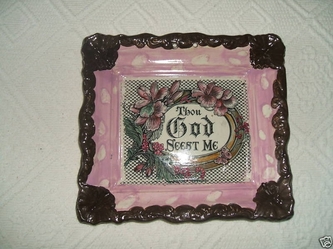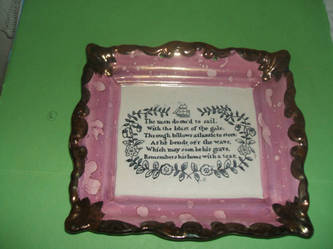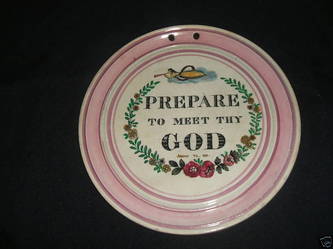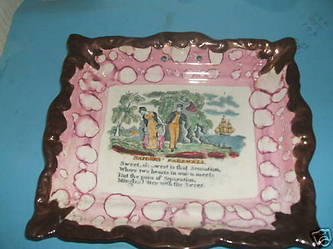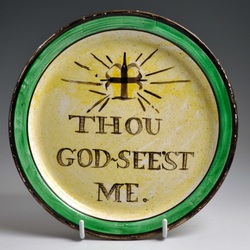1079edmund (toby-20)
For years now, an eBay seller, 1079edmund, has been buying lustre items and 'embellishing' them with enamels and pink gloss paint, with the aim of selling them for more money than they're worth.
A distinction should be made here between 'restoration' and 'forgery'. Restoration is bringing an item back to its original condition, by giving it a polish, repairing a chip, or filling a crack. Forgery is the willful attempt to deceive people into believing an item is something it never was, in order to get a higher price for it. Definitions aside, 1079edmund usually lists his over-painted items as restoration free.
In 2010, 1079edmund changed his eBay account name to toby-20.
Please contact me if you've had a bad experience with this seller: [email protected]
A distinction should be made here between 'restoration' and 'forgery'. Restoration is bringing an item back to its original condition, by giving it a polish, repairing a chip, or filling a crack. Forgery is the willful attempt to deceive people into believing an item is something it never was, in order to get a higher price for it. Definitions aside, 1079edmund usually lists his over-painted items as restoration free.
In 2010, 1079edmund changed his eBay account name to toby-20.
Please contact me if you've had a bad experience with this seller: [email protected]
Before and after shots
On the left, items bought by 1079edmund. On the right, the same items listed for sale by him a few weeks later. Through the positions of imperfections in the glaze, you can see the items are one and the same.
Over-painted plaques
The top six plaques with fake enamels over the transfers, but original borders (NB the second is a 20th century reproduction). The next three with fake pink-lustre/brown borders, but original transfers. The last three with a combination of fake borders and fake enamels on transfers.
Other over-painted items
If you think you've bought an item with fake lustre...
Compare it to the lustre on other items. The iridescent metallic glint you get with real lustre is impossible to fake the way 1079edmund does it (with gloss paint). There should be a real depth to the shine, glinting/flickering in the light (almost like a mirrored surface) as you move the object around. As time goes by, lustre does get rubbed, but even on very rubbed items you get traces of this iridescent effect (see right photo). If it looks like other pieces of lustre in this respect, chances are it’s OK. If it looks dull and flat by comparison, maybe it’s wrong. In that case, try scratching at a bit of the pink with your fingernail in an area that doesn’t notice. You might be able to tell then whether or not it is paint on the surface, rather than lustre under a glaze. Wet a piece of tissue with white spirit and rub a hidden area. If the paint has recently dried, the paint might stain the cloth. Real lustre will never do that.
Tips from Ted Knowle, a professional restorer:
Lightly run your fingertips over the suspect area – fresh paint has a slight drag to it, especially if thick (try this on newly painted woodwork at home to get a feel for it).
If oven bake-on lacquers have been used, there will be less drag, but the areas might feel warmer to the touch.
A needlepoint will scratch paint. But beware, this will also damage real glazes if you apply to much pressure.
Do not use paint stripper or bleach on gilding. A tiny drop of cellulose (car paint) thinner will soften most paints.
Lightly run your fingertips over the suspect area – fresh paint has a slight drag to it, especially if thick (try this on newly painted woodwork at home to get a feel for it).
If oven bake-on lacquers have been used, there will be less drag, but the areas might feel warmer to the touch.
A needlepoint will scratch paint. But beware, this will also damage real glazes if you apply to much pressure.
Do not use paint stripper or bleach on gilding. A tiny drop of cellulose (car paint) thinner will soften most paints.
Home-made plaques
These items baffled me for a second when I found them shuffled amongst piles of genuine 19th century plaques in an auction room. The only thing familiar about them was the brown speckled body. They are machine-made side plates from the 1980s (N.B. no hanging holes) that someone has over-painted. These weren't made by 1079edmund, and there's no evidence of any intention to defraud. My guess is that sometime after their maker died, they were boxed up with his/her collection and sent to auction, and neither the vendor nor the auction house were any the wiser.
Modern Maling?
Likewise, this hand-painted ship plate appears to be a homage to an 1828 plate by Robert Maling, on p28 of Steven Moore's 'Maling The Trade Mark of Excellence!', and shown here on the right. The flowers and leaves are distributed exactly as on the original, suggesting a direct copy. The book came out in 1989 and the current owner, Keith Cockerill, has had the plate for 30 years, so my first though was that it likely painted sometime around 1990.
However, another theory, supported by David Johnson at the Maling Collectors Society, is that it could have been made at Maling in the 1930s or 1950s when they were reproducing lustre items (see Here's One I Made Earlier in this newsletter). Keith tells me that the lustre border looks genuine (unlike the painted items above), and that would be very difficult for an amateur to fake. We may never know for sure until something similar turns up with a Maling Castle mark.
However, another theory, supported by David Johnson at the Maling Collectors Society, is that it could have been made at Maling in the 1930s or 1950s when they were reproducing lustre items (see Here's One I Made Earlier in this newsletter). Keith tells me that the lustre border looks genuine (unlike the painted items above), and that would be very difficult for an amateur to fake. We may never know for sure until something similar turns up with a Maling Castle mark.





